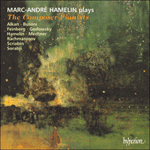
Welcome to Hyperion Records, a British classical label devoted to presenting high-quality recordings of music of all styles and from all periods from the twelfth century to the twenty-first.
Hyperion offers both CDs, and downloads in a number of formats. The site is also available in several languages.
Please use the dropdown buttons to set your preferred options, or use the checkbox to accept the defaults.

| Marc-André Hamelin (piano)» More |
I experienced a rather uneasy moment when, some time after completing the piece, I came across Sergei Taneyev’s Prelude and Fugue in G sharp minor, Op 29. I was alarmed to see that there were some startling similarities between the two fugues: same metre, same key (enharmonically), same pianistic terrains, and a very similar fugue subject. Please be assured that if this were other than mere coincidence, I would be honest enough to admit it!
from notes by Marc-André Hamelin © 2010
Rétrospectivement, il me semble que la fugue, en particulier, présente beaucoup de points communs avec le mouvement dans le style d’une tarentelle du Concerto pour piano de Busoni, que je travaillais à l’époque. Cette œuvre n’a jamais été destinée à devenir une accumulation aussi considérable de cruels procédés de virtuosité; j’ai simplement voulu explorer certaines possibilités du sujet un peu banal de la fugue. Une fois commencée, la pièce est partie un peu toute seule dans des directions que je n’avais pas prévues.
J’ai connu un moment assez difficile lorsque, quelque temps après l’avoir terminée, je suis tombé sur le Prélude et Fugue en sol dièse mineur, op. 29, de Taneïev. J’ai constaté avec frayeur qu’il y avait des similitudes saisissantes entre les deux fugues: même mètre, même tonalité (sur le plan enharmonique), mêmes terrains pianistiques et un sujet de fugue tout à fait comparable. Soyez assuré que si ce n’était pas une pure coïncidence, je l’admettrais en toute honnêteté!
extrait des notes rédigées par Marc-André Hamelin © 2010
Français: Marie-Stella Pâris
Nachträglich scheint mir die Fuge eine Menge gemeinsam zu haben mit dem Tarantella-artigen Satz aus Busonis Klavierkonzert, das ich damals gerade einstudierte. Eigentlich sollte das Werk nie zu einer so monströsen Ansammlung virtuoser Kniffe werden; ich wollte einfach nur einige Möglichkeiten des recht eigenartigen Fugenthemas testen. Aber einmal in Gang gekommen, entwickelte das Werk eine starke Eigendynamik in Richtungen, die ich nicht voraus sehen konnte.
Einige Zeit nach der Vollendung des Stückes hatte ich ein ziemlich unangenehmes Erlebnis, als mir Sergej Tanejews Präludium und Fuge in gis-Moll, op. 29 in die Hände fiel. Ich erschrak, als ich sah, dass da einige verblüffende Ähnlichkeiten zwischen den beiden Fugen vorhanden waren: derselbe Takt, dieselbe Tonart (enharmonisch), dieselben pianistischen Anforderungen und ein sehr ähnliches Fugenthema. Seien Sie versichert, dass ich, wäre das nichts als reiner Zufall, ehrlich genug wäre, es zuzugeben!
aus dem Begleittext von Marc-André Hamelin © 2010
Deutsch: Ludwig Madlener
 The Composer-Pianists The Composer-Pianists‘Everything is of the most absorbing interest; everything is impeccably performed. Irresistible for pianists, this disc should be in every musician's ... ‘Staggering feats of bravura with an effortless insouciance that defies belief. A collector's item, without doubt’ (The Sunday Times)» More |

